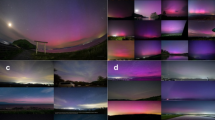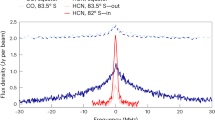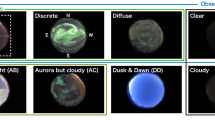Abstract
THE finest display was between 10 and 11 o'clock on the evening of the 12th, when a magnificent corona was formed almost exactly on γ Cygni. At this time the bases of the columns on the eastern horizon were distinctly red. Unfortunately the spectroscope could not be brought to bear until the aurora had faded to a small fraction of its greatest brightness. With a very small dispersion (Vogel spectroscope) the spectrum was continuous from W.L. 557 mm. to W.L. 473, with strong traces of a finely banded spectrum, terminating abruptly at the great line 557. Towards the violet an isolated line was seen and measured.
This is a preview of subscription content, access via your institution
Access options
Subscribe to this journal
Receive 51 print issues and online access
$199.00 per year
only $3.90 per issue
Buy this article
- Purchase on SpringerLink
- Instant access to full article PDF
Prices may be subject to local taxes which are calculated during checkout
Similar content being viewed by others
Author information
Authors and Affiliations
Rights and permissions
About this article
Cite this article
COPELAND, R. Observations of Auroræ on August 12 and 13. Nature 22, 510 (1880). https://doi.org/10.1038/022510a0
Issue date:
DOI: https://doi.org/10.1038/022510a0



